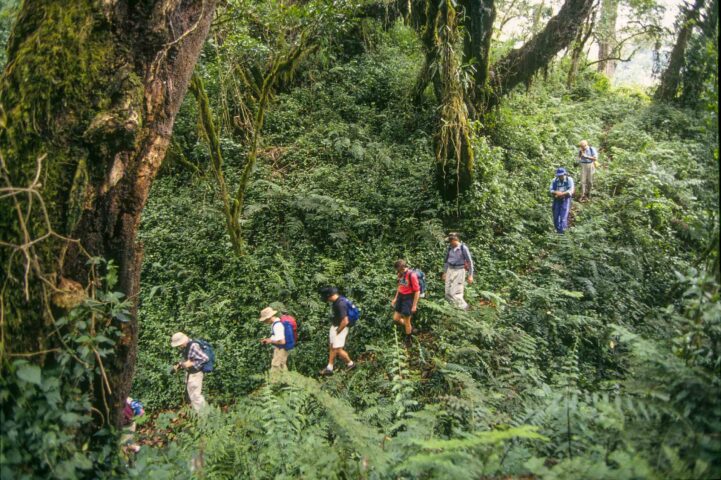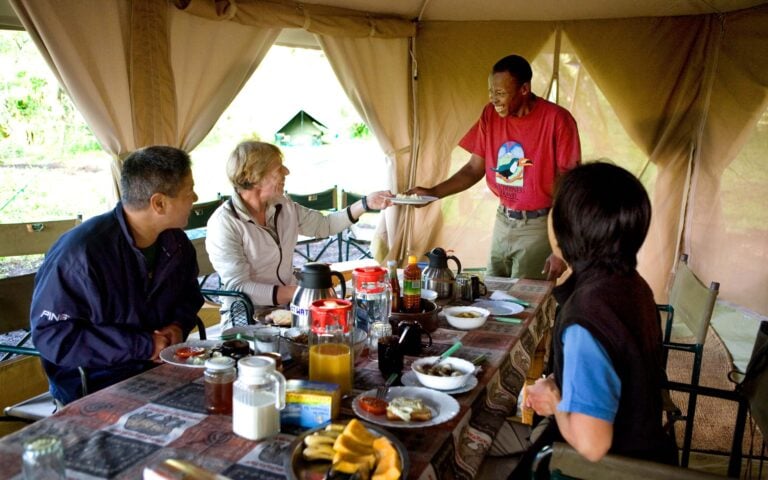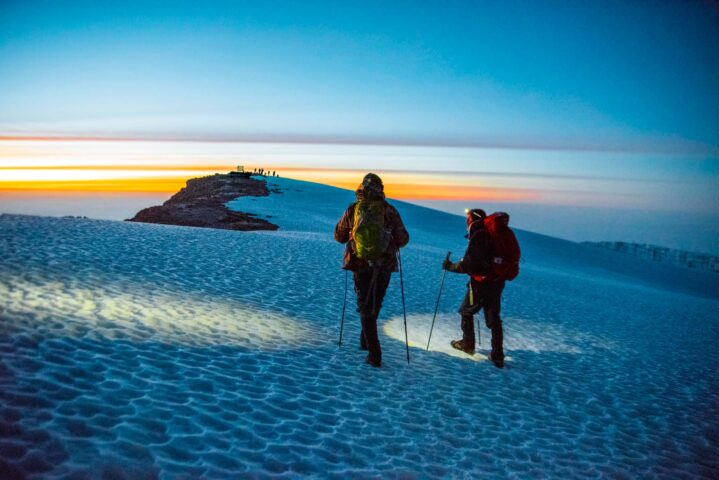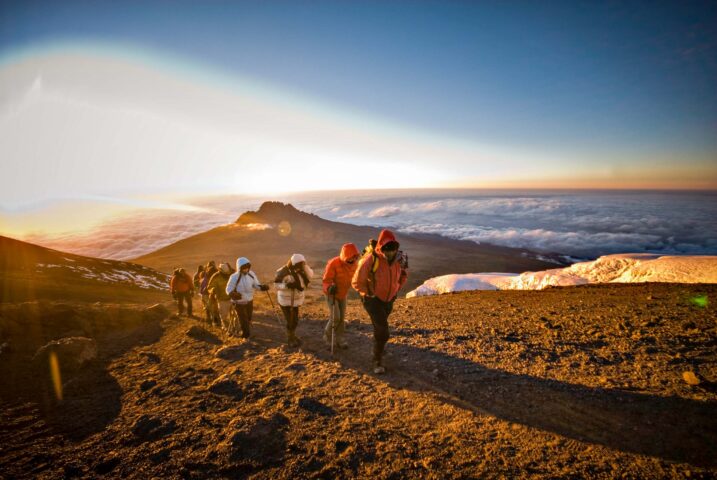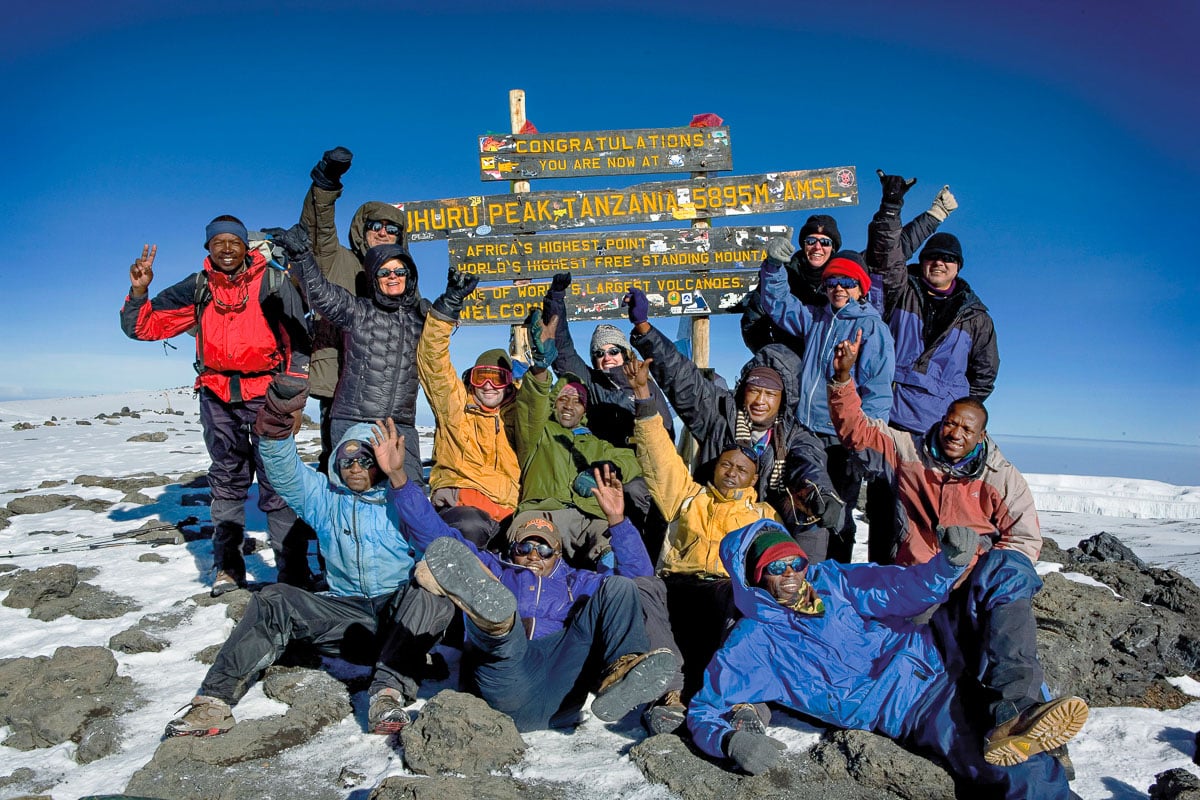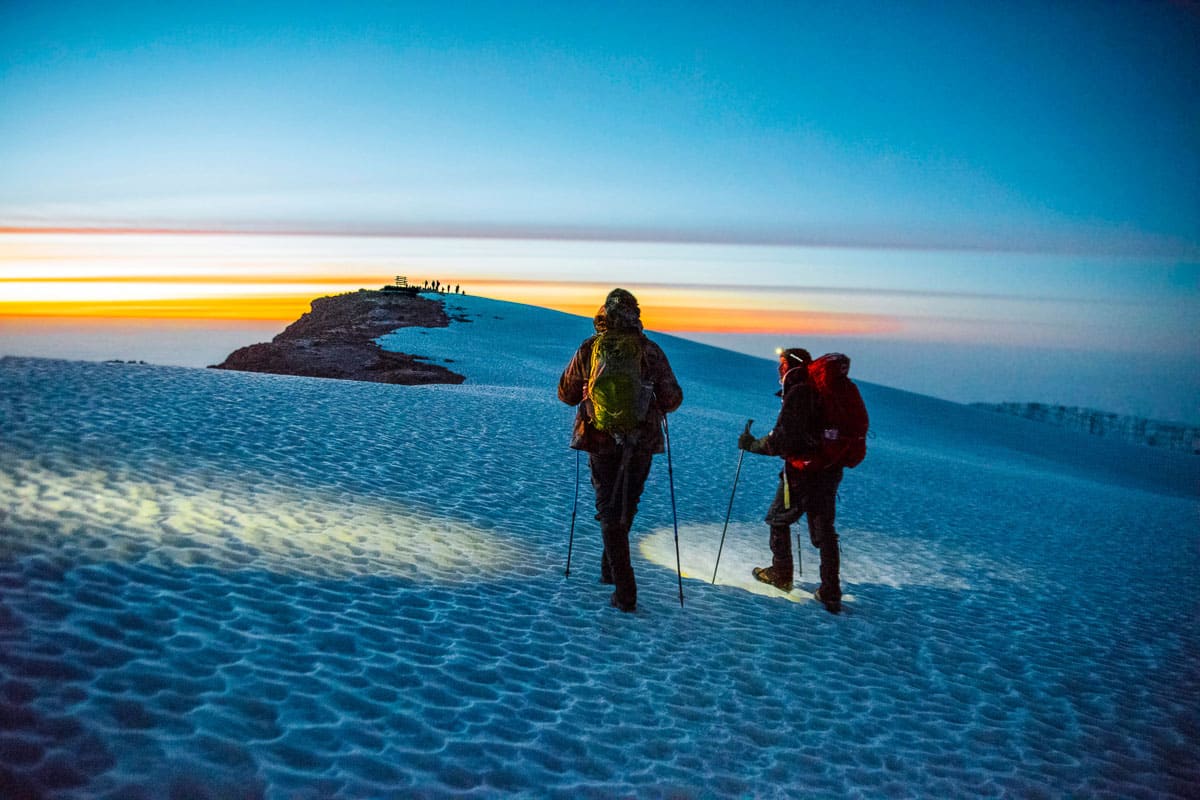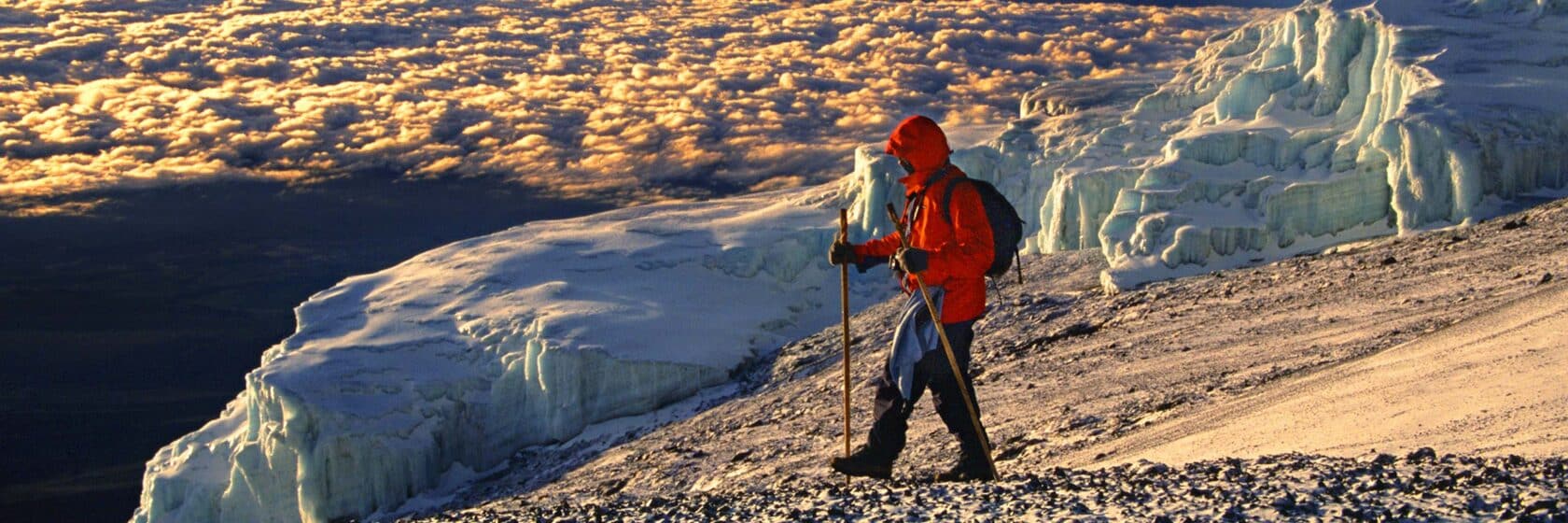
Kilimanjaro
Choosing the Best Route Up Kilimanjaro
With the many routes on Kilimanjaro, choosing which one is best for you can be a bit overwhelming.
Wilderness Travel has over 30 years of experience offering Kili climbs. We know this beautiful mountain well and have strong opinions of the best way to climb it. Below we provide information on our route as well as the most established alternate routes to help you make this important decision.
Take a look! We invite you to call us at 1-800-368-2794 or email kili@wildernesstravel.com with any questions you may have.
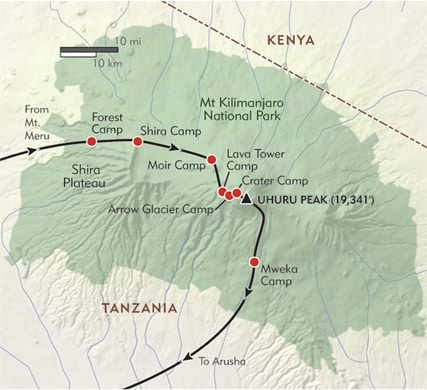
The Wilderness Travel 9-Day Lemosho-Crater Camp Route
Wilderness Travel pioneered the Lemosho-Crater Camp Route in 1989 and we consider it the best route to the summit. Why? It is the most scenic and least traveled route up Kilimanjaro. With a full seven days on the ascent, this route also provides maximum time for acclimatization and therefore the greatest chance of summit success.
We spend two nights pre-climb at a gorgeous private camp in Arusha National Park situated at an elevation of 6,500 feet. This gives our bodies a jump-start in the acclimatization process, a chance to get over jet-lag, and allows time for gear checks and optional “warm-up” hikes. Our climb commences at the Lemosho trailhead, (elevation 7,400′), then follows the Shira Route, overnighting at Forest Camp (9,150′), Shira Ridge (11,450′), Moir Camp (13,640′), and two nights at Lava Tower Camp (15,200′), which aids tremendously in acclimatization.
From here, we continue on the Western Breach Trail to climb from Arrow Glacier Camp (15,960′) to Crater Camp (18,800′), our last campsite before we summit. This day is particularly stunning, but physically challenging as we ascend 2,840′ on switchback trails through steep rocky terrain. This section can require the occasional use of your hands for stability (porter assistance is available for extra help and peace of mind) as you navigate the rocky “staircase.” Most people will need between 7 to 8 hours to accomplish this stretch, including a few rest stops to snack and drink.
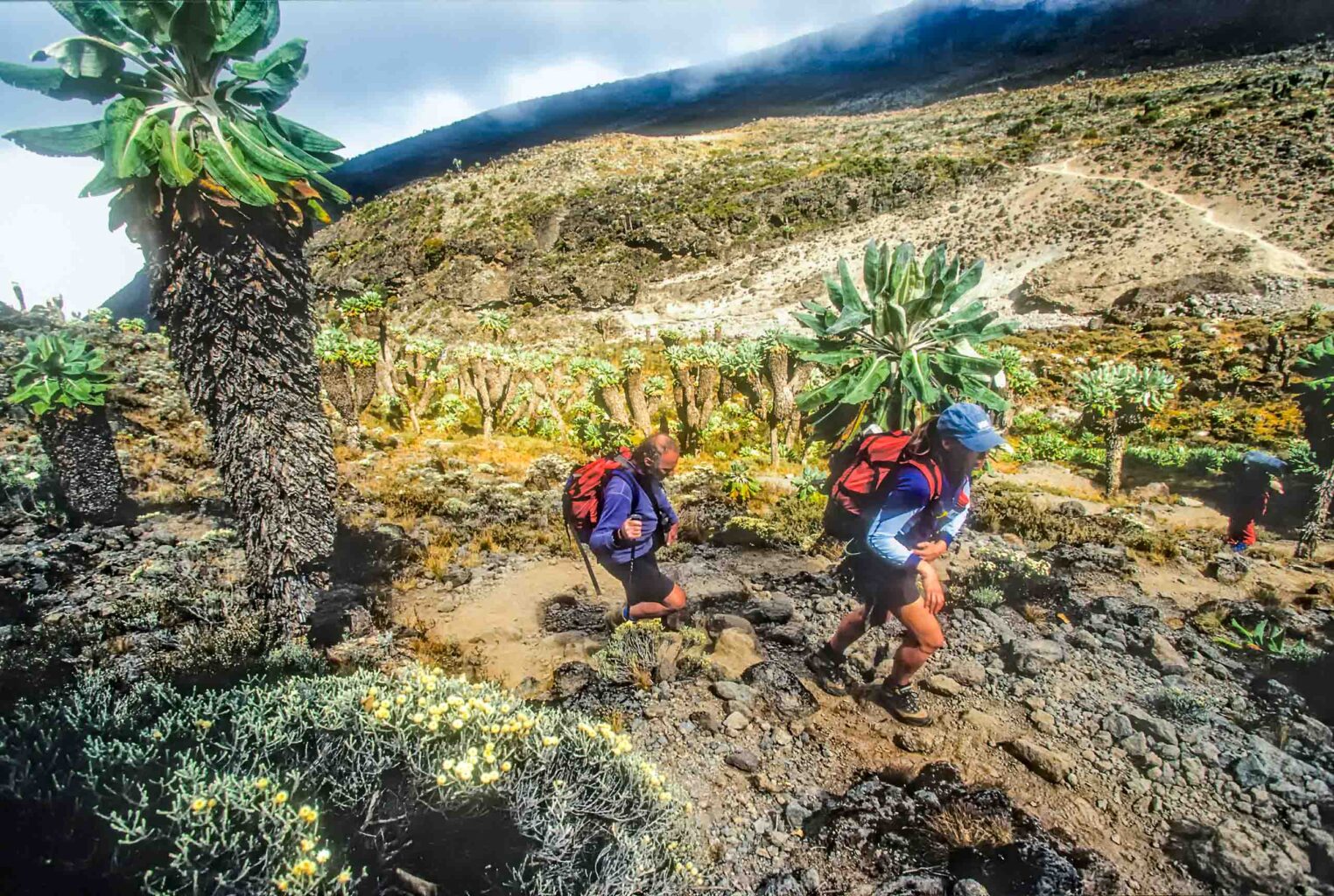
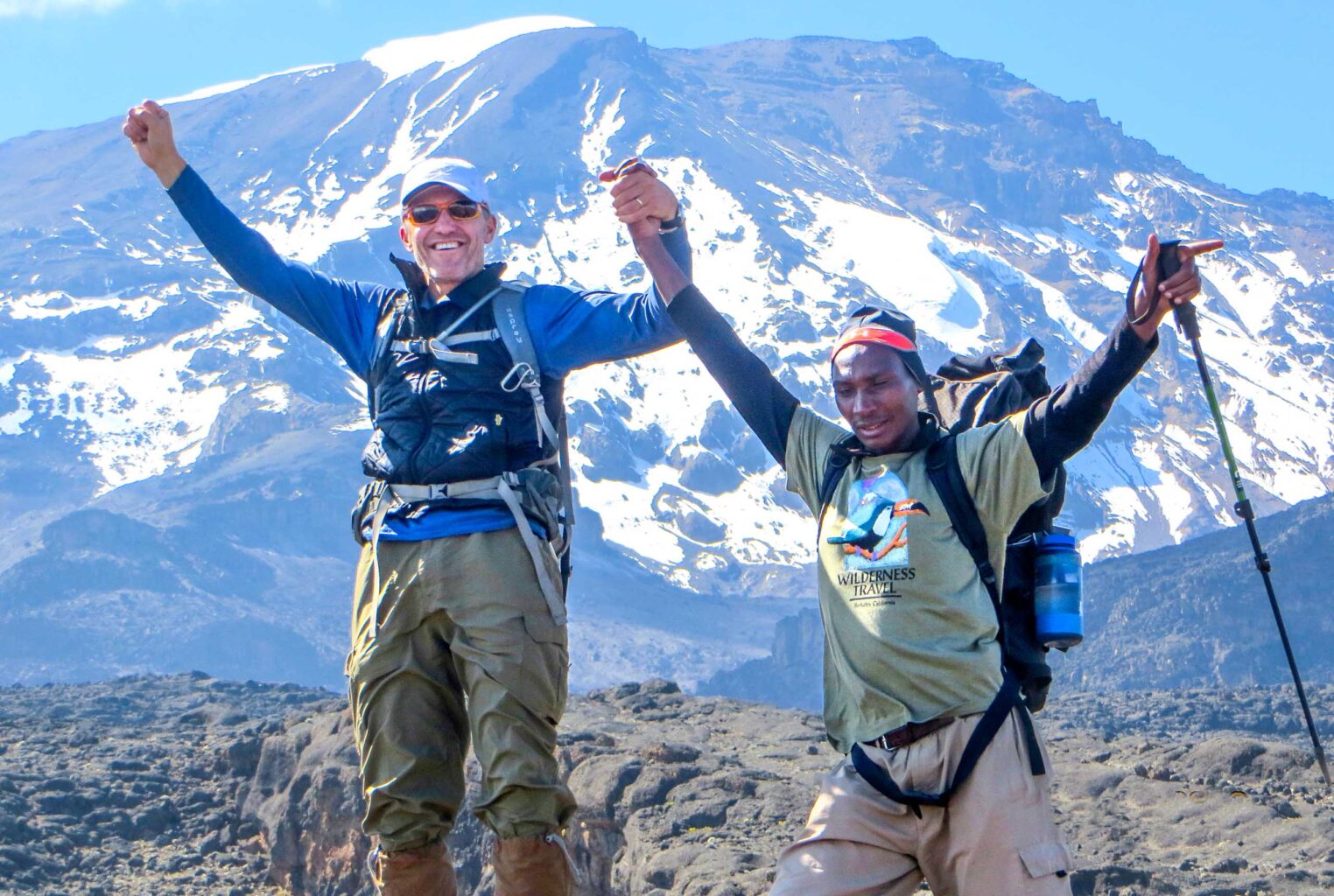
The Western Breach route was closed for two years after a rock fall in 2006. During this time the Park reassessed the route and its safety. Rock falls are a potential on all steep mountains, whether set off by wind, rain, minor earthquakes or simply a hiker above you. When the Western Breach was reopened, the route was altered to minimize the time spent hiking exposed to potential rock falls from above, but there remains a 45 minute section of the new trail which traverses a potential fall area. We will depart camp at 5:00 AM so that we cross this area before 8:00 AM while this side of the mountain remains shaded from the sun and is largely frozen in place from the night before. We arrive at Crater Camp in the early afternoon.
The camp’s location allows for the opportunity to camp near the Furtwangler Glacier and explore the inner crater, with an optional side trip to the 400 foot deep Ash Pit. Crater Camp, at 18,800′, is much higher than other camps (so proper acclimatization is crucial). It is very cold at night, but the spectacular setting and easy summit climb the next morning provide the once-in-a-lifetime experience that most are dreaming of when they think of climbing the highest mountain in Africa. We descend the other side of the mountain via Barafu and out the Mweka Gate. Descending by this route gets you down from high altitude quickly, and also shows you the advantage of our Lemosho-Western Breach approach versus this heavily used route.
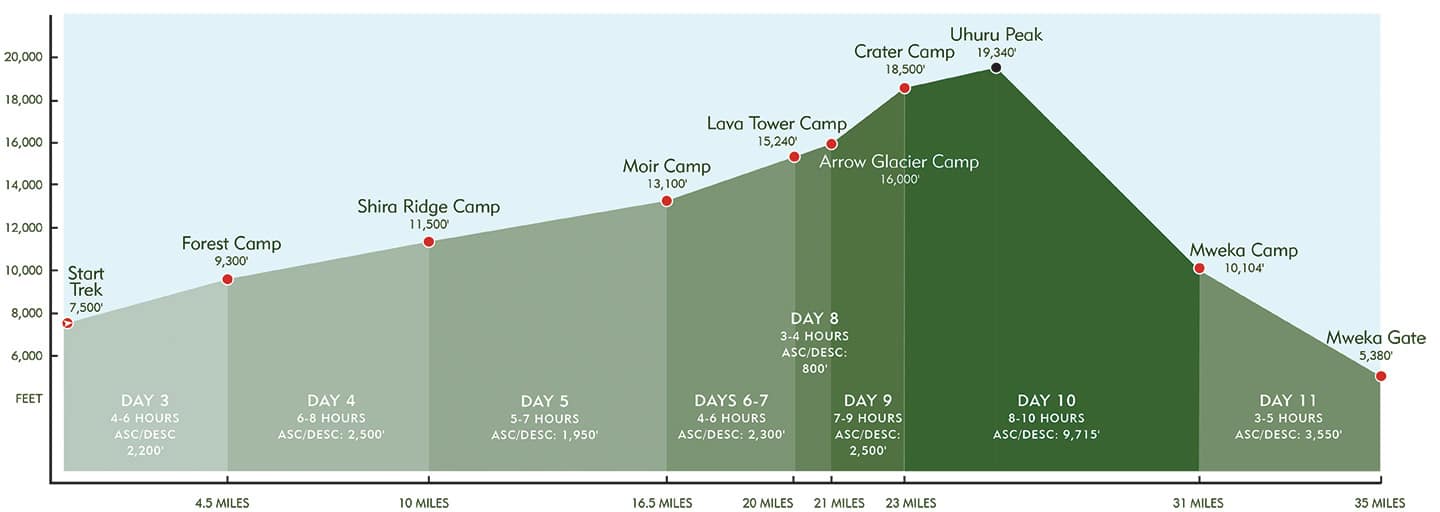
The advantages of Lemosho-Crater Camp Route are many:
- The acclimatization pattern it offers is optimal
- The rate of summit success is over 95%
- This is the only route that reasonably and safely allows you to experience the magnificent Furtwangler Glacier and the lunar landscape of the inner crater and Ash Pit up close
- Sunset from Crater Camp looking out over seemingly all of Africa is stunning
- Instead of hiking and camping with potentially one or two hundred other climbers, your group will likely have the crater rim and summit to yourself
- You arrive on the summit rested and energized to enjoy it after a fairly easy 541′ pre-dawn climb that most accomplish in less than 2 hours
- You’ll enjoy sunrise on the summit with expansive views before the daytime clouds that often circle Kilimanjaro have moved in
- In comparison, the main other choices all come together at Barafu and climb together from there to Stella Point and then the Summit. This is over a 4,000′ climb. Many do not make it beyond Stella Point and all face the need to turn around that very same day to descend 9,000′ over the same route
- Descent is via Barafu and the Mweka trailhead gate, so we will have ascended Kilimanjaro’s western flanks and come over the summit to descend on the southeastern side, having accomplished a full mountain traverse and experienced the full breadth of its ecological diversity
The following are alternate routes that Wilderness Travel does not offer (and we’ll tell you why!)
The Marangu Route, also known as the “Coca Cola” or “Tourist” Route, is the shortest, cheapest, least scenic, most crowded, and most punishing way to climb the mountain. On the Marangu Route, climbers have the least chance of summit success as the dramatic changes in altitude leave little time for the body to acclimatize. Along this route, climbers stay in crowded dorms that accommodate up to 200 people. The summit day, from Kibo Hut, requires a difficult 8-9 hour hike to the peak, with climbers waking at midnight to set out in the cold for a grueling 4,000-foot ascent at high altitudes on a steep slope in the dark. Descent is another 5-7 hours by the same route, so not only do you have a terribly long day, but a very limited experience of the mountain. Approximately 40% of all Kili climbers choose this route and fewer than half of them make the summit.
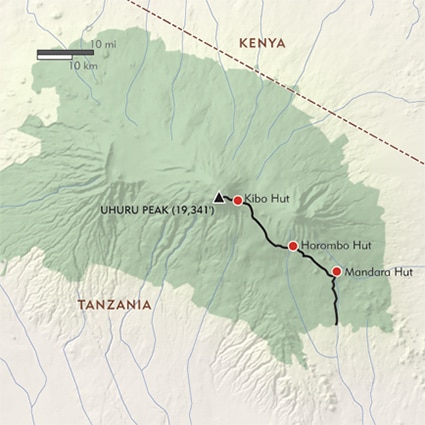
The Machame Route has over 20,000 climbers every year and it is beginning to surpass the Marangu Route in popularity. It is scenic, but overcrowded, and again allows only minimal time for the all-important acclimatization period that helps climbers reach the summit. This route begins in the south, climbs through rainforest up to the Shira Plateau, then treks east to Barafu. The summit day is similar to the Marangu “Tourist Route,” in that climbers wake at midnight and, if they make it, arrive at the summit roughly 8 hours later, hiking in less-than-ideal conditions. Some climbers see sunrise from Stella Point, but with the summit still an hour away, very few get to experience the sunrise on the summit.
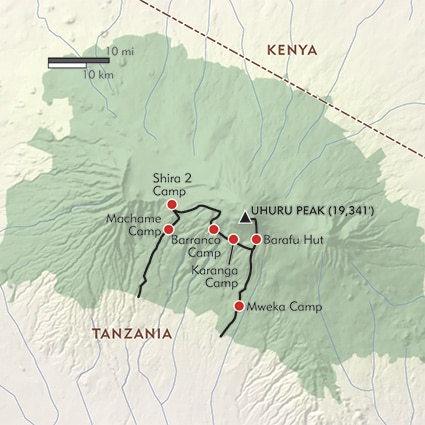
A note about Barafu (15,331 feet):
This group campsite is used by many routes as the base for the summit bid and is often packed with so many climbers that tents almost touch each other. In the evening, Barafu is noisy and climbers get very little sleep here since camp staff stay up until 10:00 PM cleaning, then start morning tea preparation at 11:30 PM to get all climbers up at midnight for their early morning summit attempt. The site itself is on a rather bleak (and waterless) ridge that was clearly chosen because it offers the last semi-level tent sites before the summit. It is a terribly overused site, and despite the best efforts of the national park authorities, it is normally not very clean. Hopefully, any travelers on this route will have joined an outfitted trip professional enough to bring their own chemical toilets, but at present the public toilets are heavily used and can often be smelled from quite a distance. Climbers descending to the Mweka gate hike past Barafu.
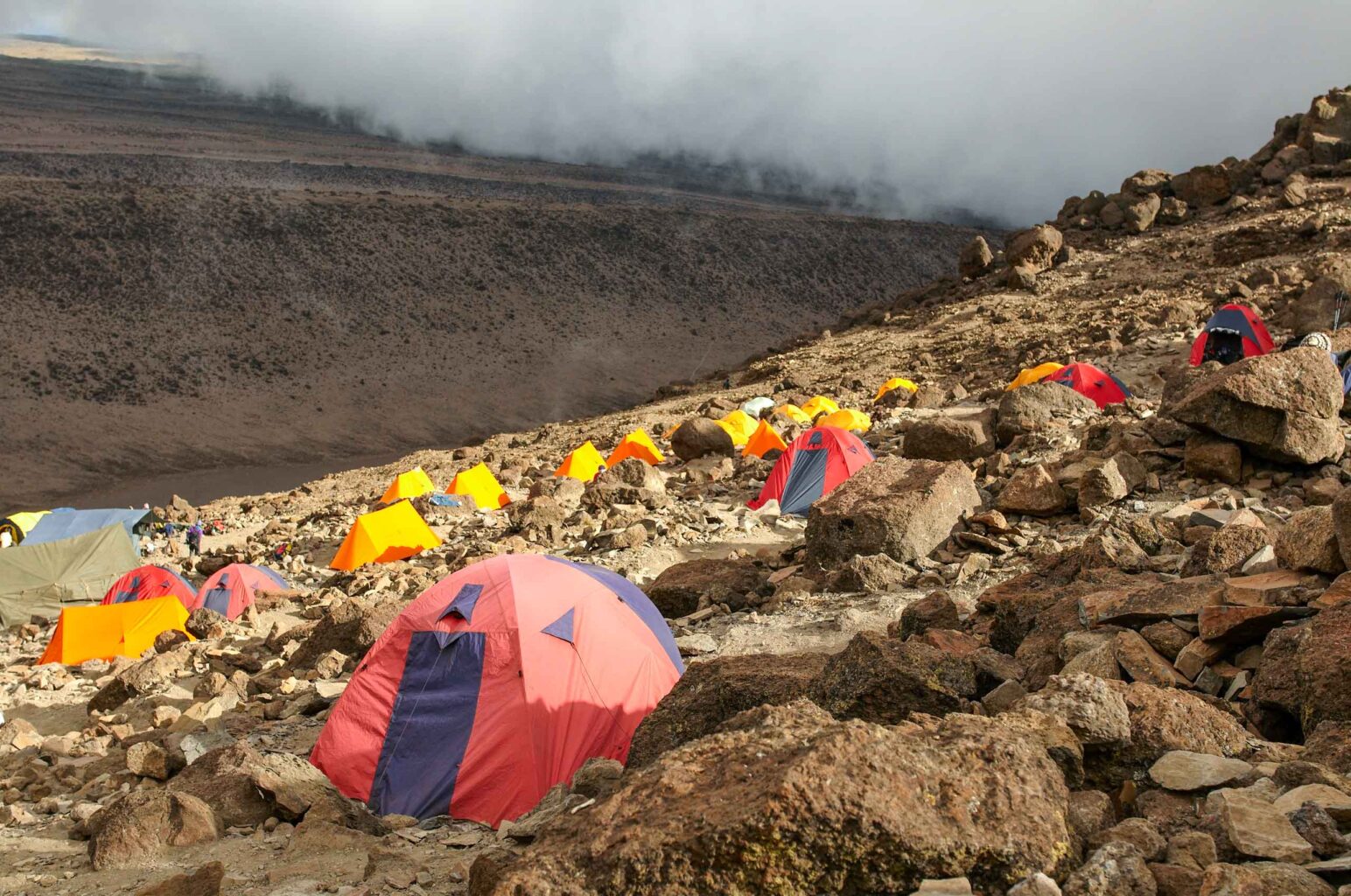
The Rongai Route approaches Kilimanjaro from the north, near the Kenya side. The first three days follow a route which, while remote and less traveled, is featureless and scenically uninteresting. This route then joins the crowded Marangu route to get to the summit. Once again, a long, difficult summit day from the Kibo Hut is required. The descent is via the Marangu Gate.
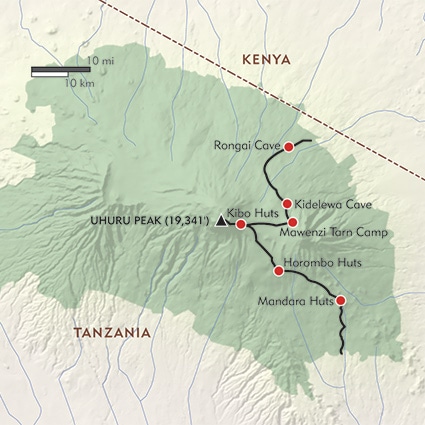
The Umbwe Route is a challenging route with few trekkers and is suggested only for experienced climbers who are short on time. The first two days are long and steep, although the views are breathtaking. This quick ascent is only recommended for climbers who have been to high altitude before and understand how their bodies react to rapid ascent. This route also includes the night at Barafu and the long, difficult summit day.
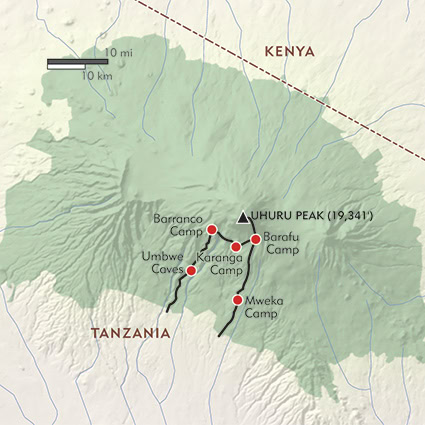
The Shira Route begins in the West, starting higher up the mountain than even Lemosho. Climbers drive from Arusha (4,200 feet) for approximately 5 hours and don’t begin hiking until they get to Shira Gate, which is at 11,800 feet! Driving to the plateau is too fast in one day and climbers can expect to have a hard time adjusting to the altitude. The route ends at Barafu with the challenging summit day of a 4,000 foot ascent followed by a 9,000 foot descent via Mweka.
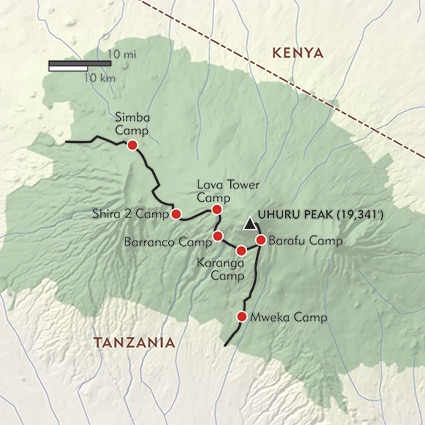
The standard 7-day Lemosho Route (often called the Western Approach) typically starts with a 4-hour drive from Arusha (4,200′) to Londorossi Gate (7,742′) and then continues by vehicle for another hour to the Lemosho trailhead. At that point, trekkers get out of the vehicle for a scenic afternoon hike to Forest Camp (9,300 feet). This rapid ascent of 5,100′ from Arusha is more than what we would recommend in one day. For the first few days, climbers enjoy stunning vistas as they cross the beautiful Shira Ridge to Shira Camp and Moir Hut. They will meet few other hikers along the way until they join the busy Machame route in Barranco Camp for the rest of their climb. This means approaching the summit from crowded Barafu and a summit day requiring a midnight wake-up for the 4,000 foot climb to the summit followed by the 9,000 foot descent via Mweka on the same day. Although this route has a scenic start, that experience is compromised by joining the overcrowded route up from Barafu to the summit.
Some 9-day variations do include an overnight camp in the high Crater Camp (18,800′) after the summit, but this is a bit illogical since the advantage of overnighting in the crater is that it gives you an easy ascent day, with the chance to enjoy sunrise on top of Kilimanjaro. The optional hike to the Ash Pit and/or ability to summit a second time on the morning you wake up in the crater, is anti-climactic after having already made the summit the day before.
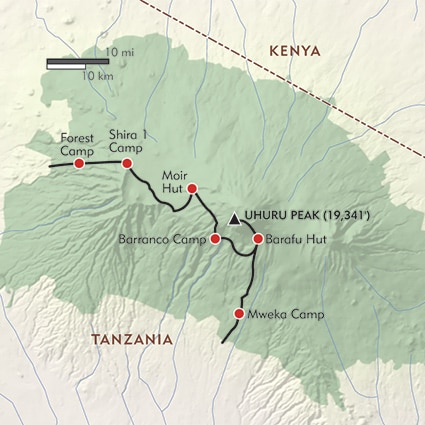
Wilderness Travel’s climb begins on this same scenic route, but we add an additional day at Lava Tower Camp (15,240′) for acclimatization. We then leave the Lemosho route behind to climb the Western Breach directly to our spectacular camp on the Crater Rim. By doing this, we avoid the night at crowded Barafu (with minimal sleep and the brutal hike to the summit that starts at midnight, as well as the full-day’s hike back down the same route that has just been climbed). On our route we ascend the Western Breach, which can take anywhere from 5 to 8 hours. There is one stretch that can require you to use your hands as you climb through the rocks. This section will feel more like a true climb than simply a hike, and many enjoy the challenge and sense of accomplishment. We then sleep at Crater Camp, with an admittedly very cold night at 18,800′. Deep sleep can be a challenge at this high altitude, and it is essential that climbers are well acclimatized. We have paced our trek to give you the necessary time to gain elevation each day in ideal increments. The benefits of this route to your summit experience are immense. They include experiencing Kili’s glaciers and central crater up close. More often than not, we have the evening on the rim and the summit the next morning all to ourselves. As you descend that afternoon, you will have the chance to compare our route with the one taken by most climbers. Our groups enjoy making that comparison!
Learn More
Talk to an Expert
Our Africa Specialists know every detail about our Kilimanjaro trips. They will be happy to answer any questions and help make sure it’s the right adventure for you. Contact us to learn more or book your trip today!

